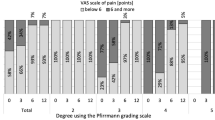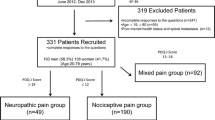Summary
Background
Epiduroscopy is a well-established diagnostic and to certain level therapeutic tool in complex situations, where conventional methods such as magnetic resonance imaging (MRI) lack power or resolution to detect pathological changes. Such a situation is primarily failed back surgery syndrome (FBSS) but also radicular pain without surgery. The aim of this study was to determine the effectiveness of epiduroscopic treatment in patients with FBSS.
Methods
A total of 79 patients with FBSS were randomized into 2 groups. The first group underwent epiduroscopy and received mechanical lysis of adhesions only, the second group received also medication into the epidural space (methylprednisolone and hyaluronidase). Patients were subsequently followed for 12 months, with evaluation also after 6 months post-epiduroscopy. Patients were checked in terms of mobility, self-care, usual activities, pain/discomfort and anxiety/depression as defined in the 5‑dimensional EQ-5D-5L questionnaire and to asses suitability of this questionnaire in chronic pain states. Data were collected using EQ-5D-5L questionnaire and also quality of life (QoL) questionnaire.
Results
In the terms of ability to walk (dimension mobility) and also ability to do housework, study or leisure activities (dimension usual activity) patients improved in both groups after 6 and 12 months after epiduroscopy. In pain dimension there was improvement mainly after 6 months which correlated also with self-care dimension and quality of life self-assessment. Results in anxiety/depression dimension were mixed.
Conclusion
Epiduroscopy appears to be a beneficial procedure for both patient groups, especially after 6 months, with some benefit remaining after 12 months. The EQ-5D-5L questionnaire seems to be a suitable and comprehensive way to assess patient health in chronic pain states.




Similar content being viewed by others
References
Kamieniak P, Bielewicz J, Grochowski C, Litak J, Bojarska-Junak A, Daniluk B, et al. The elevated serum level of IFN‑γ in patients with failed back surgery syndrome remains unchanged after spinal cord stimulation. Dis Markers. 2019;2019:2606808.
Bossher HA, Heavner JE. Incidence and severity of epidural fibrosis after back surgery: an endoscopic study. Pain Pract. 2010;10(1):18–24.
Kallewaard JW, Vanelderen P, Richardson J, Van Zundert J, Heavner J, Groen GJ. Epiduroscopy for patients with lumbosacral radicular pain. Pain Pract. 2014;14(4):365–77.
Bellini M, Barbieri M. A Comparison of non-endoscopic and endoscopic adhesiolysis of epidural fibrosis. Anaesthesiol Intensive Ther. 2016;48(4):266–71.
Di Donato A, Fontana C, Alemanno D, Di Giacomo A. Epiduroscopy in treatment of degenerative chronic low back pain: a prospective analysis and follow-up at 60 months. Clin Res Regul Aff. 2010;27(3):69–74.
Fredman B, Nun MB, Zohar E, Iraqi G, Shapiro M, Gepstein R, et al. Epidural steroids for treating “failed back surgery syndrome”: is fluoroscopy really necessary? Anesth Analg. 1999;88(2):367–72.
Geurts JW, Kallewaard JW, Richardson J, Groen GJ. Targeted methylprednisolone acetate/hyaluronidase/clonidine injection after diagnostic epiduroscopy for chronic sciatica: a prospective, 1‑year follow-up study. Reg Anesth Pain Med. 2002;27(4):343–52.
Rapčan R, Kočan L, Mláka J, Burianek M, Kočanová H, Rapčanová S, et al. A randomized, multicenter, double-blind, parallel pilot study assessing the effect of mechanical adhesiolysis vs adhesiolysis with corticosteroid and hyaluronidase administration into the epidural space during epiduroscopy. Pain Med. 2018;19(7):1436–44.
Kotz S, Lumelskii Y, Pensky M, editors. The stress-strength model and its generalizations: theory and applications. New York: World Scientific; 2003.
Zhou W. Statistical inference for P(X<Y). Stat Med. 2008;27(2):257–79.
Szende A, Oppe M, de Charro F. EQ-5D value sets: inventory, comparative review and user guide. Berlin: Springer; 2007.
Carlsson M. Assessment of chronic pain. I. Aspects of the reliability and validity of the visual analogue scale. Pain. 1983;16(1):87–101.
Baron R, Binder A, Wasner G. Neuropathic pain: diagnosis, pathophysiological mechanisms, and treatment. Lancet Neurol. 2010;9(8):807–19.
Dworkin RH, Turk DC, Farrar TJ, Haythornthwaite JA, Jensen MP, Katz NP, et al. Core outcome measures for chronic pain clinical trials: IMMPACT recommendations. Pain. 2005;113(1–2):9–19.
Herdman M, Gudex C, Lloyd A, Janssen MF, Kind P, Parkin D, et al. Development and preliminary testing of the new five-level version of EQ-5D (EQ-5D-5L). Qual Life Res. 2011;20(10):1727–36.
Gustavsson A, Bjorkman J, Ljungcrantz C, Rhodin A, Rivano-Fischer M, Sjolund KF, et al. Pharmacological treatment patterns in neuropathic pain—lessons from Swedish administrative registries. Pain Med. 2013;14(7):1072–80.
Palmer N, Guan Z, Chai NC. Spinal cord stimulation for failed back surgery syndrome, patient selection considerations. Transl Perioper Pain Med. 2019;6(3):81–90.
Vanelderen P, Van Boxem K, Van Zundert J. Epiduroscopy: the missing link connecting diagnosis and treatment? Pain Pract. 2012;12(7):499–501.
Aasa B, Berglund L, Michaelson P, Aasa U. Individualized low-load motor control exercises and education versus a high-load lifting exercise and education to improve activity, pain intensity, and physical performance in patients with low back pain: a randomized controlled trial. J Orthop Sports Phys Ther. 2015;45(2):77–85. B1–4.
Author information
Authors and Affiliations
Corresponding author
Ethics declarations
Conflict of interest
R. Rapčan, L. Kočan, V. Witkovsky, J. Mláka, M. Griger, M. Burianek, S. Rapčanová, A. Hammond, Ľ. Poliak, R. Tirpák, J. Šimonová, F. Sabol, and J. Vašková declare that they have no competing interests.
Additional information
Publisher’s Note
Springer Nature remains neutral with regard to jurisdictional claims in published maps and institutional affiliations.
Rights and permissions
About this article
Cite this article
Rapčan, R., Kočan, L., Witkovsky, V. et al. EQ-5D-5L questionnaire as suitable assessment of quality of life after epiduroscopy. Wien Klin Wochenschr 132, 526–534 (2020). https://doi.org/10.1007/s00508-019-01590-z
Received:
Accepted:
Published:
Issue Date:
DOI: https://doi.org/10.1007/s00508-019-01590-z




